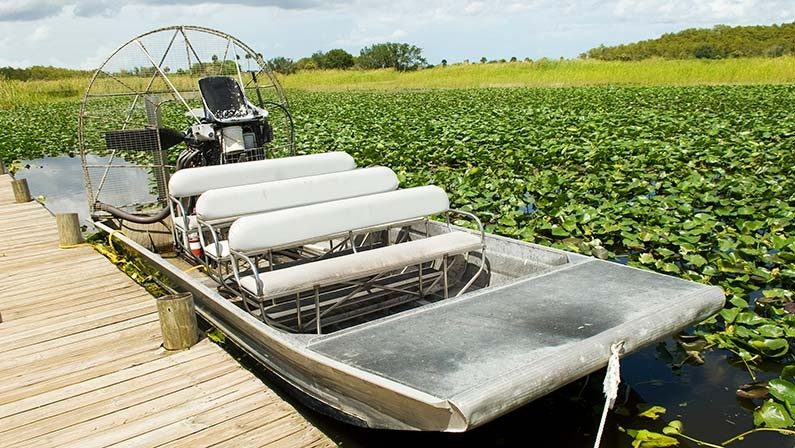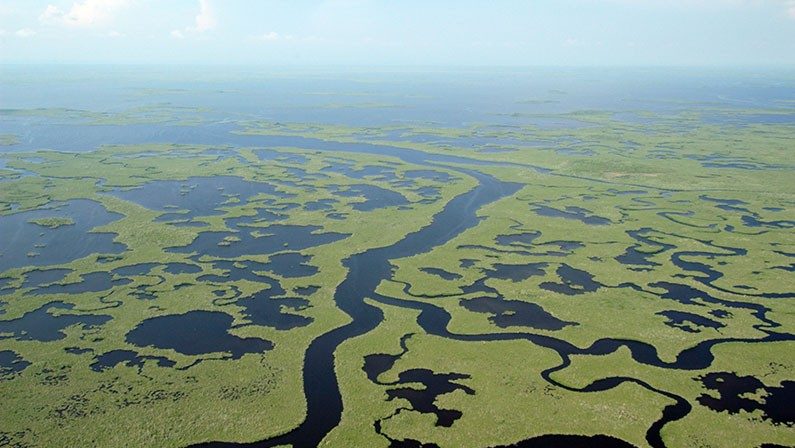The River of Grass – the nickname bestowed upon the Everglades National Park by naturalist Marjory Stoneman Douglas – sounds like an impossible description. But one visit to this enormous subtropical wetland and you’ll see exactly what she meant.
The ecosystem, by definition a watershed, incorporates standing and tidal waterways of varying salinity with pine forests, sawgrass prairies and mangrove islands. In fact, there are nine distinct habitats contained within the Everglades National Park, including ponds, sloughs, marshes and uplands – a mosaic of varying blues, greens and golds.
A World Heritage Site, International Biosphere Reserve and a Wetland of International Importance, the Everglades is home to countless species of land and aquatic plants and animals, including those rare or endangered such as the elusive Florida panther, the manatee, the American alligator and the American crocodile. For those toting binoculars and a scorecard, the Everglades are an aviary paradise, with a rainbow of birds that range from the small yet brilliantly hued Indigo Bunting, Purple Gallinule and Roseate Spoonbill to the ungainly Great Blue Heron, Sandhill Crane and Wood Stork. The Everglades is also a winter nesting area for America’s pride and joy, the Bald Eagle. The boardwalk at the Anhinga Trail, named for the oily, black bird that spreads its wings like a cape to dry, and Eco Pond Trail, where wading birds gather in the morning, are two of the renowned locations in the park for bird-watching, especially during the winter dry season.
.jpg)
Indeed, the very vastness of this historic wetland, coupled with the amount of wildlife you can spot and the adrenaline-inducing activities you can take on, is almost stupefying. At more than 1.5 million acres, it ranges from the southeast coast of Florida to the southwest, with points of entrance only an hour from the metropolitan areas of Miami or Naples on either side. That said, the Everglades aren’t nearly as expansive as they once were. Before the land was “reclaimed” (drained) for human development, it covered nearly 11,000 square miles. By the early 1940s, the damage to the fragile ecosystem had been done, but thanks to advocates such as Douglas, the Everglades National Park, the third largest in the nation, was established.
Like most national parks, the Everglades has several entrances and visitors’ centres with concession stands and rangers, and precisely where you drop in depends on your particular interests. From the southwest, sightseeing tours and fishing charters for Bass, Bluegill, Redfish, Sea Trout and Snapper in the Florida Bay, Whitewater Bay or the waters around the Ten Thousand Islands by boat should be booked at the Flamingo or Gulf Coast marinas. (Fishing by shore is extremely limited and not recommended.) You can also kayak or canoe, and if you’re an enthusiast, the Wilderness Waterway is a 99-mile camping and paddling pursuit that will take you at least a week. Any journey by any kind of boat, however, should be a guided one unless you’re experienced and have a good knowledge of the area, as the shallow flats and passages through sea grass are rife with oyster beds, reefs and sandbars that aren’t always marked and difficult for novices to read..

If you desire a closer, more immediate experience, you can hike or bike through the Everglades National Park in the areas between Miami and Naples on US 41/SW 8th St/Tamiami Trail: Along the Pineland Trails of the Long Pine Key Area, which are basically ruts that were created by loggers and farmers back in the 1940s. Alternatively, try the Old Ingraham Highway, a 22-mile round trip, or the Flamingo Trails, including the Snake Bight Trail and the Rowdy Bend Trail (hiking is allowed on all nine of the Flamingo Trails, but bicycles on only the aforementioned). On the southeastern coast, Shark Valley, a fifteen-mile paved loop where alligators sprawl uncaring along the road, soaking up the southern sunshine, is one of the most popular places to ride. While it may seem scary to step or ride around the reptiles, keep in mind that they only hunt when they’re in the water, and unless you provoke them, they’re completely disinterested in you while they’re on the land. If you don’t feel like you’re up to fifteen miles of exercise, you can take a guided tram tour, a two-hour encyclopaedic journey.
On the way to Shark Valley, you’ll pass the Miccosukee Village. The Miccosukee was one of the tribes of Native Americans that existed long before Ponce de Leon “discovered” America 500 years ago. Today, the Miccosukee and Seminole tribes maintain government-sanctioned reservations in the Everglades National Park, and visitors are welcome to the villages they maintain to demonstrate their way of life. The Miccosukee Village features an Indian Museum with historic artefacts, Tribal art and photography. It also offers demonstrations on traditional craft-making, alligator and wildlife shows and airboat rides to a 100-year-old hammock Indian camp. Finally, the Miccosukee restaurant allows you to taste native delicacies including fry bread, frog legs, ‘gator and catfish.

If you just can’t bring yourself to sample the wildlife you’ve just viewed, stop in at the Pit Bar-B-Q for smoked chicken and ribs, plus beans and rice with a Latin flair, which is also located on Tamiami Trail. Restaurants located in the Everglades itself tend to serve good ol’ Southern cuisine or focus on regional seafood, such as City Seafood, located in Everglades City. Others have developed from airboat concession stands, such as Coopertown Restaurant on Miami’s side of the Tamiami Trail, and offer a dose of local colour to go along with the cornmeal-breaded, fried alligator tail that’s on the menu.
As for airboats, they’re not allowed in the Everglades National Park. However, a northern tract of the River of Grass was added in 1989, and it’s here on the Tamiami Trail, running between the two coasts, that private concessions operate tours. Some find the airboats loud and intrusive, but children tend to like them, and the tours are generally educational. Plus, locals who regularly fish the area for bass and trout rely on them to move over mere inches of water. Sometimes, they’re the only way to get into a deeper part of the ecosystem without getting your feet wet. Then again, some don’t mind a little water. If that’s you, feel free to join a ranger for slough slogging – a wet hike through the River of Grass – for the ultimate up-close Everglades experience.
Written by Jen Karetnick
Image credits:
Everglades Swamp Motorboat © iStock: Juanmonino
Fishing at Dusk NPS Photo G. Gardner, Courtesy Everglades NPS
Lane River NPS Photos, Courtesy Everglades NPS
Swamp Wetland Mangrove Landscape in Everglades © iStock: YinYang



